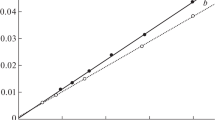Summary
One significant source of error has been shown to arise from hand spotting of small volumes of solution when preparing the initial spots [1]. Machine spotting reduced this error considerably and the present paper shows that no further error is produced during the movement of the solute from the initial to the final spots. In extreme conditions there was evidence that lateral diffusion of solutes during the chromatographic run may produce slight errors but these would not occur in normal conditions of chromatography. However a more serious source of error was found in the fact that different sheets may vary in chromatographic behaviour; in ten sheets examined the slopes of the regression lines relatingy (parameter measured) andx (quantities in initial spots) varied significantly between two of the sheets. These differences can be correted for by using standard and test solutions for each sheet.
Zusammenfassung
Es ist gezeigt worden, daß erhebliche Fehler auftreten können, wenn beim Aufbringen der Start-Flecken geringe Lösungs-Volumina von Hand aufgegeben werden (1). Durch das Aufbringen mit Maschinen wurde dieser Fehler beträchtlich reduziert, und es wird in der vorliegenden Arbeit gezeigt, daß während der Wanderung der Substanz vom Start zum Endfleck kein weiterer Fehler mehr verursacht wird. Unter extremen Bedingungen gab es Anzeichen dafür, daß die Lateraldiffusion der Substanz während der Migration leichte Fehler hervorrufen kann; doch würden diese nicht unter normalen chromatographischen Bedingungen auftreten. Eine ernstere Fehlerquelle wurde jedoch in der Tatsache gefunden, daß verschiedene Bögen in ihrem chromatographischen Verhalten variieren können; bei zehn untersuchten Bögen zeigten sich zwischen zwei der Bögen wesentliche Unterschiede im Abfall der Regressions-Linien, die y (gemessener Parameter) und x (Mengen in den Start-Flecken) in Beziehung setzen. Diese Unterschiede können korrigiert werden, indem man bei jedem Bogen Eich- und Testlösungen benutzt.
Sommaire
Il a été montré qu'une source importante d'erreurs vient de l'application manuelle de petits volumes de solution lors de la formation des taches initiales (1). L'application mécanique réduit considérablement cette erreur; le travail présent montre qu'aucune autre erreur ne se produit pendant la migration des taches. Sous des conditions extrêmes une diffusion latérale des solutés pendant le processus chromatographique peut produire des légères erreurs; mais celles-ci ne se produiront pas dans des conditions chromatographiques normales. Toutefois, une source d'erreurs plus sérieuse a été trouvée dans le fait que des feuilles différentes peuvent varier dans leur comportement chromatographique; parmi 10 feuilles examinées il y en avait deux dont les pentes des lignes de régression qui relient y (paramètre mesuré) et x (quantités dans les taches initiales) variaient de façon importante. Ces différences peuvent être corrigées en utilisant des solutions étalon et des solutions d'éssais pour chaque feuille.
Similar content being viewed by others
References
Fairbairn, J. W. andS. J. Relph, J. Chromatog.,35 (1968), 494.
Bridger, J. E. andS. J. Relph, British Patent application, Nos. 54215/65 40136/66.
Giddings, J. C. andR. A. Keller, J. Chromatog.,2 (1959), 626.
Keller, R. A. andJ. C. Giddings, J. Chromatog.,3 (1960), 205.
Giddings, J. C., J. Chromatog.,5 (1961), 46.
Bush, I. E., Chromatography of Steroids, (1961), Pergamon Press.
Consden, R., Second Int. Chromatog. Symp., (1964), Elsevier, Amsterdam.
Cassidy, H. G., Anal. Chem.,24 (1952), 1415.
Block, R. J., E. L. Durrum andG. Zweig, A manual of Paper Chromatography and Paper Electrophoresis., 2nd Ed., p. 61, (Academic Press, New York, 1958).
Partridge, S. M., Nature,164 (1940), 443.
Saunders, L. andR. Fleming, Mathematics and Statistics, (1957), The Pharmaceutical Press, London.
Fisher, R. A. andF. Yates, Statistical tables for biological, agricultural and medical research, 3rd. Ed., (1949), Cliver & Boyd, Edinburgh.
Fairbairn, J. W. andP. N. Suwal, Pharm. Acta. Helv.,34 (1959), 561.
Fairbairn, J. W. andG. Wassel, J. Pharm. Pharmacol.,15 (1963), 216T.
Nybom, N., J. Chromatog.,28 (1967), 447.
Fisher, R. B., D. S. Parsons andR. Holmes, Nature, Lond.,164 (1949), 183.
Author information
Authors and Affiliations
Rights and permissions
About this article
Cite this article
Fairbairn, J.W., Relph, S.J. Sources of error in quantitative paper and thin layer chromatography II. Movement of solutes from initial to final spot. Chromatographia 2, 204–207 (1969). https://doi.org/10.1007/BF02262407
Received:
Accepted:
Issue Date:
DOI: https://doi.org/10.1007/BF02262407




